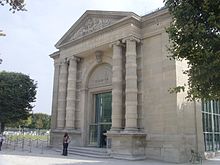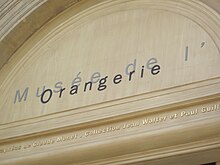Musée de l’Orangerie
75001 Paris, France
Website – www.musee-orangerie.fr
The Musée de l’Orangerie is an art gallery of impressionist and post-impressionist paintings located in the west corner of the Tuileries Gardens next to the Place de la Concorde in Paris. Though most famous for being the permanent home for eight Water Lilies murals by Claude Monet, the museum also contains works by Paul Cézanne, Henri Matisse, Amedeo Modigliani, Pablo Picasso, Pierre-Auguste Renoir, Henri Rousseau, Alfred Sisley, Chaim Soutine, and Maurice Utrillo, among others.
Location
The gallery is on the bank of the Seine in the old orangery of the Tuileries Palace on the Place de la Concorde near the Concorde metro station.
History
On April 12, 1922 Claude Monet signed a contract donating the Nymphéas series of decorative panels painted on canvas to the French government, to be housed in redesigned, oval rooms at the Orangerie. With input from Monet, the head architect at the Louvre, Camille Lefèvre, drafted new plans and elevations in 1922 to house Monet’s large Nymphéas canvases, incorporating natural light, plain walls, and sparse interior decoration. According to Hoog’s research, “funds were made available on August 17, 1922, work began in October and seems to have been finished in [the] following year.” Unwilling to relinquish his final works of art, these water lilies paintings stayed with Monet until his death on December 5, 1926. On January 31, 1927 the Laurent-Fournier company agreed to install and mount the panels (a process that involved gluing the canvas directly to the walls), and the paintings were in place by March 26 of that year. On May 17, 1927 Monet’s Nymphéas at the Musée de l’Orangerie opened to the public.
According to Hoog, “In August 1944, during the battle for the Liberation of Paris, five shells fell on the rooms of the Nymphéas; two panels (those situated on the wall between the two rooms) were slightly damaged and immediately restored. In 1984, this restoration work was renewed and a general cleaning was effected.”
In January 2000, the museum was closed for renovation work, completely reviewed and restructured, and re-opened to the public in May 2006.
Paul Guillaume‘s widow, Mrs. Jean Walter, donated their modern art collection to the Musées Nationaux in 1958. The Orangerie has housed the Paul Guillaume collection of 19th and 20th century modern paintings since 1965.
Monet’s Water Lilies
A cycle of Monet’s water-lily paintings, known as the Nymphéas, was arranged on the ground floor of the Orangerie in 1927. They are available under direct diffused light as was originally intended by Monet. The eight paintings are displayed in two oval rooms all along the walls. The museum was closed to the public from the end of August 1999 until May 2006. For several months before it was closed there was a special exhibit of Monet’s Nymphéas that were gathered from museums throughout the world. More than 60 of the 250 paintings he made of the water lilies in his garden were included. The walls were repainted in shades of purples and violet for this special exhibit. The Orangerie was renovated in order to move the paintings to the upper floor of the gallery.
Art museum – Impressionist and Post-impressionist paintings


